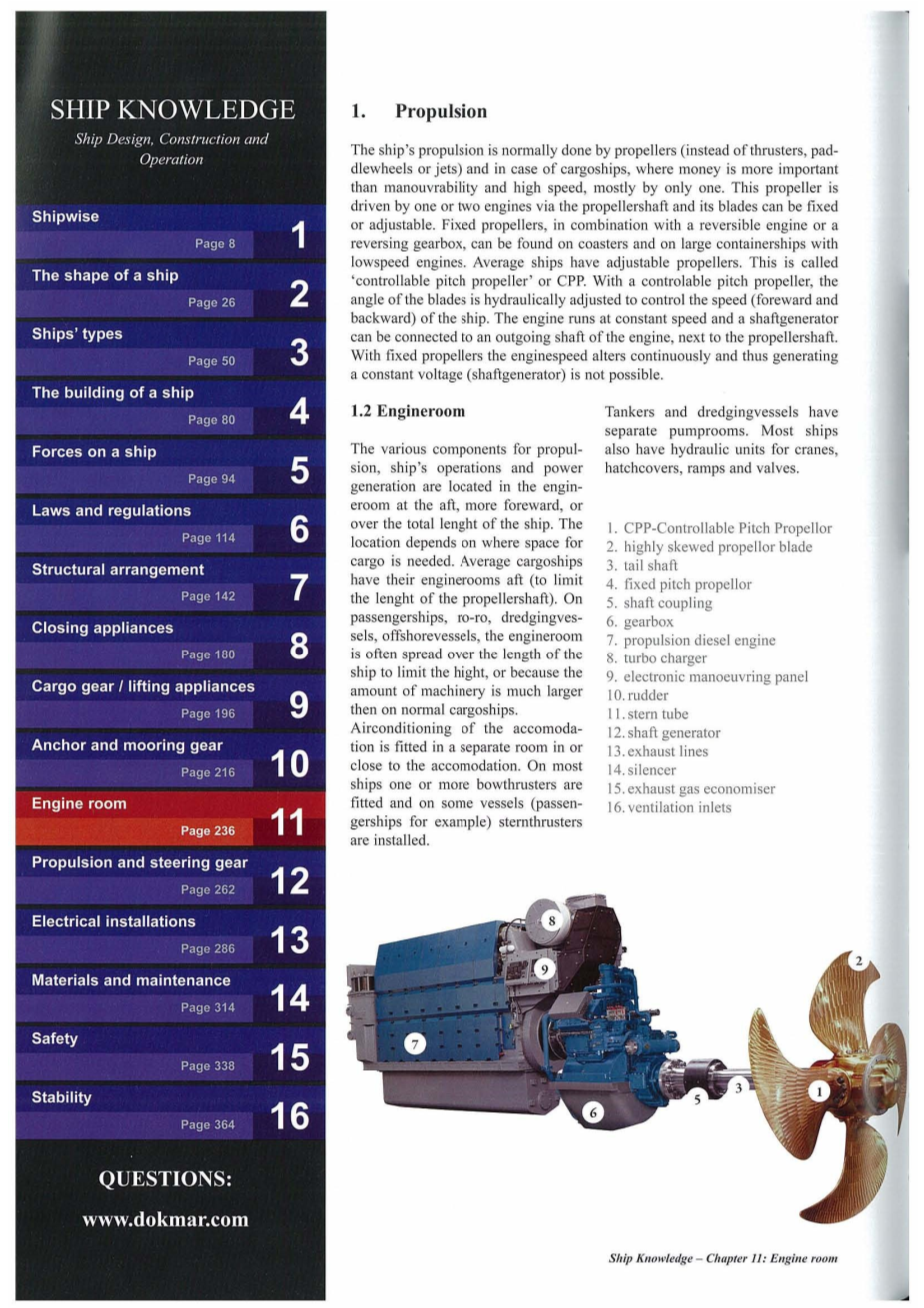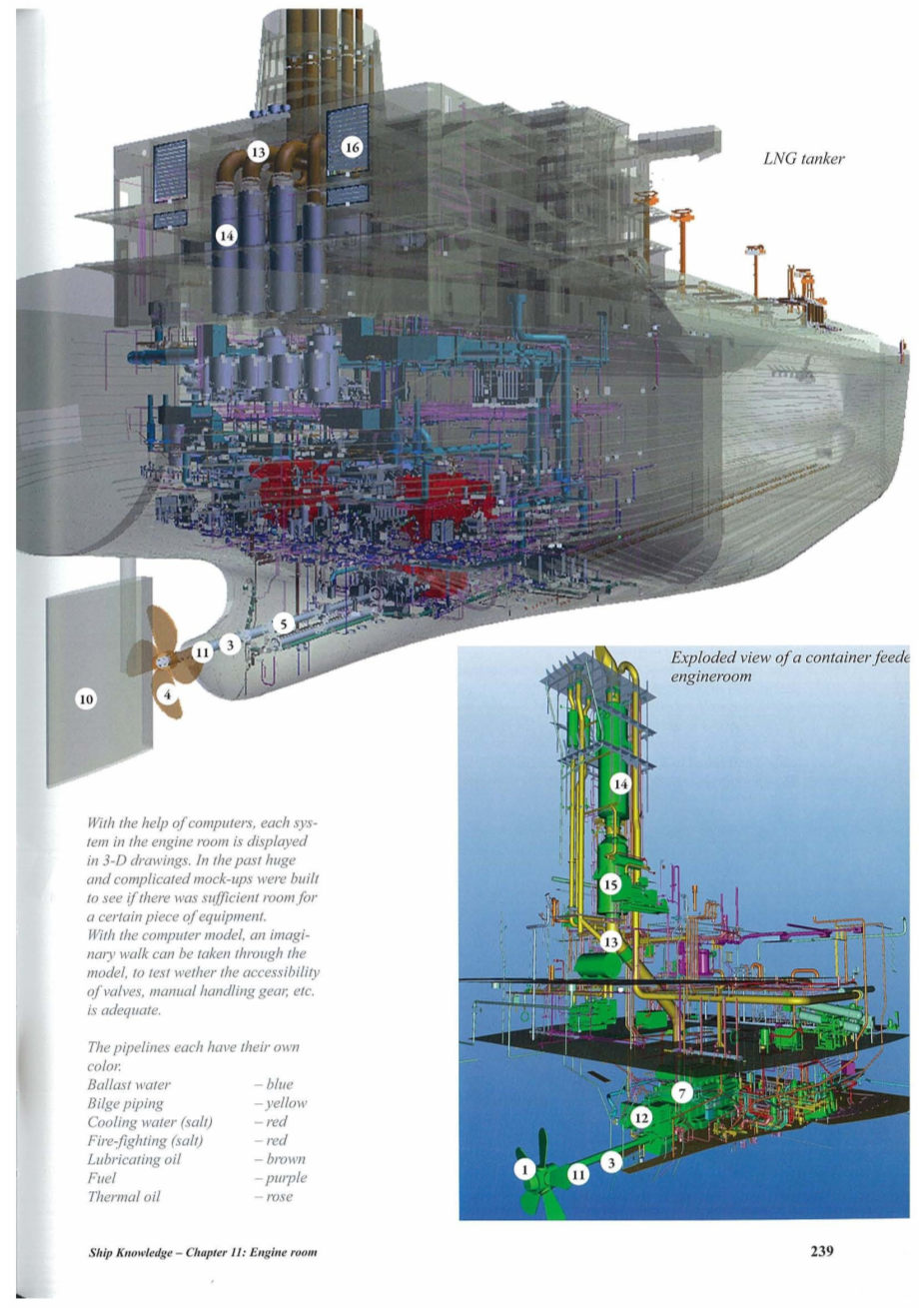

英语原文共 24 页,剩余内容已隐藏,支付完成后下载完整资料
|
Chapter 11 Engine room |
第十一章 机舱 |
||
|
1 Propulsion The ship#39;s propulsion is normally done by propellers (instead of thrusters, paddlewheels or jets) and in case of cargo ships ,where money is more important than maneuverability and high speed, mostly by only one. This propeller is driven by one or two engines via the propeller shaft and its blades can be fixed or adjustable. Fixed propellers, in combination with a reversible engine or a reversing gearbox, can be found on coasters and on large containerships with low speed engines. Average ships have adjustable propellers. This is called #39;controllable pitch propeller#39; or CPP. With a controllable pitch propeller, the angle of the blades is hydraulically adjusted to control the speed (fore ward and backward) of the ship. The engine runs at constant speed and a shaft generator can be connected to an outgoing shaft of the engine, next to the shaft. With propeller fixed propellers the engine speed alters continuously and thus generating a constant voltage (shaft generator) is not possible. |
1动力 船舶的推进通常是由螺旋桨(也可以是涡轮、桨轮或喷气机)来完成的。而对于货船来说,经济性比操纵性和高速更重要,所以其推进主要是由一个螺旋桨完成的。螺旋桨由一个或两个发动机通过螺旋桨轴驱动,其叶片可以是固定或可调节的。固定螺旋桨与可逆发动机或可逆变速箱结合在一起,可以在沿(近) 海航船和装有低速发动机的大型集装箱船上找到。现在大多船舶都用可调螺旋桨。这被称为“可调螺距螺旋桨”或CPP。调距桨运用液压调节桨叶的角度,控制船舶的速度(前进和后退)。发动机以恒速运转,轴带发电机可以连接到发动机的输出轴上,靠近螺旋桨轴。使用固定螺旋桨时,发动机转速会不断变化,因此不可能产生恒定电压(轴带发电机)。 |
||
|
1.2 Engine room The various components for propulsion, ship#39;s operations and power generation are located in the engine room at the aft, more fore ward, or over the total length of the ship. The location depends on where space for cargo is needed. Average cargo ships have their engine rooms aft (to limit the length of the propeller shaft).On passenger ships ,ro-ro ,dredging vessels, offshore vessels, the engine room is often spread over the length of the ship to limit the height , or because the amount of machinery is much larger then on normal cargo ships. |
1.2机舱 用于推进、船舶操作和发电的各种部件都在位于船尾或中部的机舱内。货物的位置取决于货物需要的空间。一般的货船都在船尾安装发动机(以限制螺旋桨轴的长度)。在客船、滚装船、挖泥船、近海船舶上,发动机室通常往船的长度方向扩展,以限制高度,或许是因为机械的数量比正常货船上的要大得多。 |
||
|
Air conditioning of the accommodation is fitted in a separate room in or close to the accommodation. On most ships one or more bow thrusters are fitted and on some vessels (passenger ships for example) stern thrusters are installed. |
住宿区的空调安装在单独的房间内或靠近住宿区。在大多数船舶上,安装了一个或多个艏推进器,在某些船舶(例如,客船)上安装了艉推进器。 |
||
|
Tankers and dredging vessels have separate pump rooms . Most ships also have hydraulic units for cranes, hatch covers, ramps and valves. |
油轮和疏浚船有单独的泵室。大多数船舶也有用于起重机、舱口盖、坡道和阀门的液压装置。 |
||
|
|
|||
|
|
|||
|
|
|||
|
With the help of computers, each system in (he engine room is displayed in 3-D drawings. In the past huge and complicated mock-ups were built to see if there was sufficient room for a certain piece of equipment. With the computer model, an imaginary walk can be taken through the model, to test wether the accessibility of valves, manual handling gear, etc. is adequate. |
在计算机的帮助下,机舱中的每个系统都显示在三维图形中。过去,人们要建造巨大而复杂的实体模型,以确定是否有足够的空间放置某一设备。现在利用计算机模型,就可以在模型中进行假想行走,以测试阀门、手动操作装置等的可接近性是否足够。 |
||
|
The pipelines each have their own color. Ballast water - blue Bilge piping - yellow Cooling water (salt) - red Fire-fighting (salt) - red Lubricating oil - brown Fuel - purple Thermal oil - rose |
每条管道都有自己的颜色。 压载水 ——蓝色 舱底管道 ——黄色 冷却水(海水) ——红色 消防(海水) ——红色 润滑油 ——棕色 燃油 ——紫色 专用导热油 ——粉红色 |
||
|
|
|||
|
|
|||
|
|
|||
|
1. main engines (4) 2. auxiliary diesel generators 3. shaft generator (2) 4. gearbox 5. main exhaust lines 6. auxiliary exhaust lines 7. silencer 8. exhaust gas boilers / ecol1omisers 9. shafting 10. tail shaft 11. CPP 12. rudder (2) 13. intermediate shaft bearing 14. mooring winch 15. anchors 16. bow thrusters 17. stern thruster 18. stabilizer |
1. 主发动机(4) 2.辅助柴油发电机 3.轴发电机(2) 4.齿轮箱 5.主排气管 6.辅助排气管 7.消音器 8.废气锅炉/ECOLOMIERS 9.轴系 10.尾轴 11.CPP 12.方向舵(2) 13.中间轴轴承 14.系泊绞车 15.锚 16.船首推进器 17.船尾推进器 18稳定器 |
||
|
All engine rooms consist of at least: main engine(s) (propulsion), auxiliary engines (power generation), cooling water system, lubricating oil system, fuel system, compressed air system (starting-, control- and working air), drinking water system, sewage system, bilge system, ballast system, boiler (heating of tanks, accommodation etc.), refrigerating system, firefighting system, storage tanks for lubricating oil, hydraulic oil, fuel oil, thermal oil, spare parts store, control room and workshop. |
所有发动机室至少包括:主机(推进)、辅助发动机(发电)、冷却水系统、润滑油系统、燃油系统、压缩空气系统(启动、控制和工作空气)、饮用水系统、污水系统、舱底系统、压载系统、锅炉(油箱加热、宿舍使用等)、制冷系统、消防系统、润滑油储罐、液压油、燃油、导热油、备件库、控制室和车间。 |
||
|
1.3 Engine types |
1.3发动机类型 |
||
|
A ship#39;s diesel engines can be twos-stroke or four-stroke. Two-stroke means that it takes two movements of the piston, down and up, to complete one combustion process. With four-stroke engines, it takes four strokes. |
一艘船的柴油发动机可以是两冲程或四冲程。 二冲程意味着活塞需要上下两个运动来完成一个燃烧过程。 四冲程发动机则需要四个冲程。 全文共55454字,剩余内容已隐藏,支付完成后下载完整资料 资料编号:[3048] |
||
以上是毕业论文外文翻译,课题毕业论文、任务书、文献综述、开题报告、程序设计、图纸设计等资料可联系客服协助查找。


